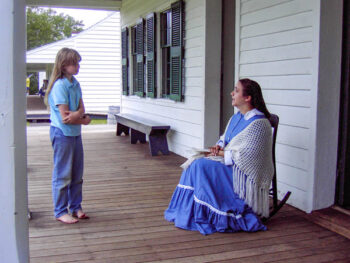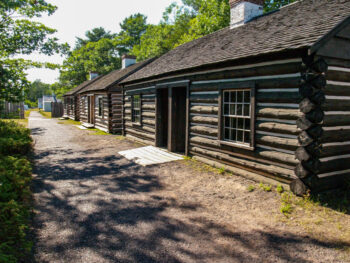This summer the Michigan History Center will enter its 41st season of a unique program in historic site interpretation at Fort Wilkins Historic State Park, at Copper Harbor, in Keweenaw County.
The Fort Wilkins living history, or “role-playing” program, was first introduced in cooperation with Michigan Technological University in 1976. The program is unique in that it combines an established interpretive program, professional museum staff and the History Center’s Future Historians youth program.
During the summer, college students and younger Upper Peninsula students are trained as costumed interpreters and portray characters from the past at the fort. The interpretive program has been an effective educational tool for participants in the program, as well as nearly 150,000 annual visitors to Fort Wilkins.
Located off the beaten path, Fort Wilkins provides an ideal setting for role-playing interpretation. Situated on a narrow strip of land between Copper Harbor and Lake Fanny Hooe, the fort stands as an excellent example of a mid-19th–century military post.
Built in 1844, 19 buildings survive, including two sets of company barracks, officers’ quarters, mess halls, a storehouse, post hospital, guardhouse, blacksmith shop, bakery and married enlisted men’s cabins. Of these, 12 remain from 1844 construction with another seven structures that are also historic but were rebuilt or restored later based on historical and archaeological research.

The buildings and fort grounds serve as the interpreters’ stage, and except for an occasional passing airplane or motorboat on Lake Fanny Hooe, people can view a landscape that closely resembles what soldiers and copper miners first encountered in the 1840s.
Here, for 10 weeks each summer, costumed interpreters bring the site to life.
Living history programs, like the one at Fort Wilkins, use character portrayals to help reveal the stories of a historic site. Role playing, or first-person interpretation, is a form of living history where interpreters assume the roles of period inhabitants or visitors to the site.
In one sense, these performers serve as living exhibits and convey information about the past. At Fort Wilkins, the fictitious characters of Private and Mrs. Jonathan Holmes, Quartermaster Sergeant Patrick O’Neill and 2nd Lieutenant and Mrs. Mueller are based on actual members of the U.S. Army garrison stationed there between 1869 and 1870.
These characters were not selected at random – they portray the hierarchy of military society. They also better represent the past by offering visitors a variety of people to chat with.
For example, at different stations throughout the fort, a costumed interpreter portrays a soldier on “fatigue” or work detail, guard duty or just relaxing in his quarters while off duty.
Through conversation, the interpreter tells the visitor about everyday events and explains not just what happened at Fort Wilkins but how and why it happened. For example, in his role as Quartermaster Sergeant O’Neill, an interpreter describes the difficulties of supply at Fort Wilkins.

“We have a hard time moving goods to this post, being 600 miles from regimental headquarters at Detroit barracks,” the interpreter says. “Nearly a quarter of sowbelly that recently landed here is bad, and one out of three barrels of hardtack is soft and moldy. Since I arrived here in ‘69, we have never seen a shipment that was 100% straight.”
Another interpreter portrays an officer’s wife who, in 1870, represented the higher class of military society. In her role as Mrs. Juliet Mueller, the wife of the 2nd lieutenant, she performs a daily routine of domestic chores and an occasional “promenade” around the fort grounds.
On occasion, the interpreter invites visitors into her parlor and talks about other families at the fort and the troubles of being stationed at a frontier Army post. This form of role-playing interpretation allows the public to converse with the interpreter and gives them the chance to learn more about the way people lived on this remote frontier, situated at the very northern tip of Michigan.
Besides conversation, visitors can be drawn into the past by hands-on experiences. As part of their interpretation, Fort Wilkins role-players perform routine tasks, such as washing laundry, hauling water, cleaning accouterments and other everyday chores.
These activities are neither demonstrations nor rehearsed productions, but instead provide an accurate setting for dialogue and other interaction with the visitor.
For example, while scrubbing clothes near her cabin, as laundress Kate Holmes, an interpreter invites a youngster to help her with her chores. She then relates, in detail, the proper methods of laundering clothes and frequent problems of not receiving pay for her labors. In fact, laundresses at Fort Wilkins should have received a dollar per man, per month and petitioned the U.S. government for outstanding debts in 1870.
The role-playing program offers visitors the chance to learn about the historic site in a way that signs, period rooms and audiovisual programs may not. Role-playing can also enhance the visitor’s experience by opening areas normally closed to the public.
Visitors are invited into period settings to sit in a horsehair rocking chair, write with a steel pen or handle reproduction artifacts. However, not all visitors are comfortable with this form of historic interpretation. Many people are uneasy talking to costumed interpreters, while others may not understand the program. Here lies the challenge for living history, as the interpreter needs to open the door and invite visitors to step through it.

To be successful, interpreters at Fort Wilkins continuously work to expand their knowledge of the period and society they portray. To personify the past accurately, role-playing interpretation should be based on sound research, and both formal and independent research is an essential part of an interpreter’s training.
Participants in the Fort Wilkins living history program receive an extensive reading list and a program manual. These resources serve as their primary information base for character development and for use when interpreting facts for the public. Accuracy is key, and virtually everything that will be said, including the least bit of gossip, is based on historical research.
Role-playing interpretation offers visitors an opportunity to learn about the past and invites them to compare the past and the present. One objective of the Fort Wilkin’s living history program is to educate visitors about what life may have been like in earlier times and help them understand how it contrasts with contemporary society.
Visitors’ living history experience may persuade them to learn more about the site through traditional museum exhibits and publications.
Whether through conversation, entering a period environment, or hands-on activities, the interpretation program allows visitors to gain important insights into 19th-century garrison life. Accurately portrayed, living history and role-playing interpretation can provide a meaningful learning experience for visitors of all ages.
The exhibits and interpretation at Fort Wilkins Historic State Park, located off U.S. 41, in the Keweenaw Peninsula, are administered by the Michigan History Center, part of the Michigan Department of Natural Resources, in partnership with the DNR Parks and Recreation Division.
Museum hours are 8 a.m. to dusk daily from mid-May to mid-October. For more information about the Fort Wilkins living history program call 906-475-7857.


